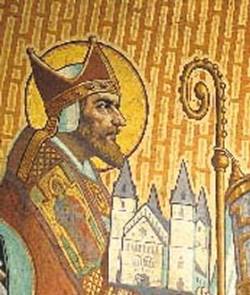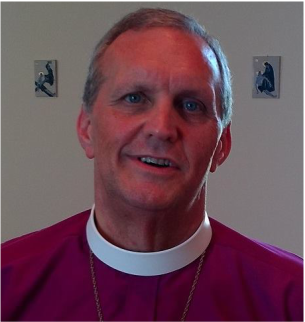
“They devoted themselves to the apostles’ teaching and to fellowship,
to the breaking of bread and to prayer” (Acts 2:42).
Dear Sisters and Brothers in Christ,
The Local Church has been historically understood as comprising the bishop, laity, and clergy of a specific geographical area, in accord with the ancient Catholic tradition – an understanding of the Church which is embraced by our Synodal Catholic Diocese of the Southeast. The Local Church is constituted whole, full and complete with these three elements – yet remains part of the One, Holy, Catholic and Apostolic Church (marked as such, which is rightly called a “communion.”) “There is one body and one Spirit, just as also you were called in one hope of your calling; one Lord, one faith, one baptism, one God and Father of all who is over all and through all and in all.” (Ephesians 4:5-6)
Local Churches are “in communion” with one another. With the bishop and laity the local Church is fully constituted – and in relation to other fully constituted local Churches becomes what has been historically called an “eparchy” (in Greek) – or the familiar term, diocese. So a diocese is correctly called “the Church,” for it is comprised of all the elements of “the Church.” No local faith community is complete without its bishop – the successor of the apostles, elected by the people of that diocese and ordained to that holy order of bishop by other bishops who share in the historic collegial apostolic succession of the Church. Also, no bishop is complete without the gathering in of faith communities around him/her.
It is important to note here that, in our Diocesan Constitution and Norms, a bishop serves a term when elected to be the bishop of the diocese. However, her/his sacramental holy order as bishop is permanent, even after she/he is no longer the bishop (ordinary) of the diocese – just as a priest remains a priest even after her/his term ends as the pastor of a parish. For Catholics, the sacrament of holy orders is permanent.
In the diocese, faith communities (parishes, religious orders, and ministries) experience the presence of the Risen Christ among us in the proclamation of the Word of the Gospel – especially at the Eucharist – and in the celebration of the sacred Mysteries (the Sacraments). In the diocese, the faithful gather as a Holy Synod to discern the call of the Spirit. In the diocese, we find the people of God, the baptized laity – from whom are called those ordained to minister in the specific holy orders of deacon, presbyter and subsequently, bishop. These are all constitutive elements of the fullness of the Catholic Church in a given locality or region.
We have experienced remarkable growth. In the face of such growth, this understanding of the ancient Catholic structure and polity is being examined and tested in the very existence of our Diocese. It is our intention to share with you our understanding of our continuing development.
So much of the history of the Church chronicles its splintering and division into denominations that do not share the same ecclesiology – that is, the same theological understanding of “Church.” In the early centuries, the Church showed a sense of inclusivity in its structure, as the laity and clergy elected their bishops, and were consulted in the decisions of their bishops. This is affirmed in the teaching of Pope Leo I (d. 461 CE), who stated that “the one who is to govern all should be chosen by all.” This inclusive posture is demonstrated even earlier by Saint Cyprian (d. 258 CE), who wrote “I have made it a rule, ever since the beginning of my episcopate, to make no decision merely on the strength of my own personal opinion without consulting you [the priests and deacons] and without the approbation of the people.”
As the centuries continued, the Church was influenced by the political forces of civil government, until the point of its abandonment of this early formula of the consultation of the people in the decisions of their bishop. This unfortunate development was further complicated in Western Christianity as an imperial bureaucracy developed that continued to acquire power and centralize the administration of the Church in Rome.
Previous to this rise of the centralized control of the Western Church, the bishop of Rome enjoyed the position of being the first among equals among the bishops of the Western Church. As the Patriarch of the West, the bishop of Rome was seen as the spokesperson of the Western Churches, and even as the spokesperson and senior bishop of the universal Church. Rome became the yardstick of faith, by which the orthodoxy of other Churches was measured. Rome was the court of appeal to which other Churches appealed in disputed issues.
Yet many of the bishops of Rome sought an even more powerful role, as was shown in the administration of medieval popes – such as the bureaucracy established by Gregory VII in the eleventh century. This moved the bishop of Rome from the role as arbiter of the Catholic tradition to that of administrator for the entire Western Church. Rome took upon itself the appointment of the diocesan bishops for all the Roman Catholic dioceses of the world with one exception.
In the year 1145, Eugene III granted the See of Utrecht the right of election of its own bishops. The Fourth Council of the Lateran confirmed this grant in 1215. In 1520, Pope Leo X in the decree, Debitum Pastoralis, granted to the See of Utrecht the right of adjudication of its own affairs without reference to the tribunals of Rome. The theological faculties of Paris and the Louvain, in 1717, verified this privilege, known as the Leonine Privilege. The difficulties resulting from the subsequent activities of the counter-reformers caused the Ancient Catholic Church of the Netherlands to become an autonomous part of the one, holy, Catholic and apostolic Church.
This bureaucracy outside of the See of Utrecht further distanced the people from their participation in the processes of the Local Church, as the bishop of Rome gained more authority over the workings of local dioceses, as well as the internal workings of religious orders, religious schools and other Catholic institutions. Of course, such structures of Church authority mirrored the imperial structures of civil government, as European kings and emperors consolidated their power.
Prior to this rise of the papacy, provincial synods met with regularity, bishops consulted with the local “chapters” of the clergy, and the people had some voice (even if only by acclamation) in the choice of the bishop. This accumulation of power by the Roman Church culminated in the sixteenth century with the bishop of Rome – and the curial bureaucracy of the Roman Church – supplanting the authority of even an ecumenical council, so that after the Council of Trent there were no more ecumenical councils for three hundred years.
Now our own beloved Diocese is engaged in its own growth, and is seeking to revive the polity and culture of the ancient Catholic Church as part and parcel of our identity, an identity that has always been ours as a Diocese. We are learning the lesson that the efforts of self-determination must be affirmed, while carefully maintaining the unity of the apostolic faith, the sacramental life, and the structures and practices of the Catholic Church developed in the early part of the first millennium.
We place ourselves at the feet of the Lord, seeking the wisdom and light of the Holy Spirit, as we discern and seek communion with the Old Catholic Church, Province of the United States. They are sisters and brothers of like mind and heart in their understanding and practice of being Church together. The Old Catholic tradition has always upheld the ancient understanding of episcopal ministry within the Local Church, a tradition that we have always maintained from the establishment of our own Diocese. Pause can be given to any fear otherwise.
Currently, I exercise pastoral leadership among you as the one you chose in 2010 and consecrated as Diocesan Bishop, for the proper exercise of the episcopal ministry as defined by our Constitution and Norms, and as informed by the ancient Catholic tradition. It is my firm conviction that the enthusiasm for the work of the Church is nurtured when the Diocese is cultivated as the basic structure of the Church – with its own synodal structure, and its own ministries, that respond to its own needs. The autonomy of each diocese, and the collaboration of dioceses in regional efforts gave a good balance to the efforts of the early Church. This, I believe, is our primary model as a Diocese.
May the grace of our Lord Jesus Christ, the love of God, and the communion of the Holy Spirit be with you all.
to the breaking of bread and to prayer” (Acts 2:42).
Dear Sisters and Brothers in Christ,
The Local Church has been historically understood as comprising the bishop, laity, and clergy of a specific geographical area, in accord with the ancient Catholic tradition – an understanding of the Church which is embraced by our Synodal Catholic Diocese of the Southeast. The Local Church is constituted whole, full and complete with these three elements – yet remains part of the One, Holy, Catholic and Apostolic Church (marked as such, which is rightly called a “communion.”) “There is one body and one Spirit, just as also you were called in one hope of your calling; one Lord, one faith, one baptism, one God and Father of all who is over all and through all and in all.” (Ephesians 4:5-6)
Local Churches are “in communion” with one another. With the bishop and laity the local Church is fully constituted – and in relation to other fully constituted local Churches becomes what has been historically called an “eparchy” (in Greek) – or the familiar term, diocese. So a diocese is correctly called “the Church,” for it is comprised of all the elements of “the Church.” No local faith community is complete without its bishop – the successor of the apostles, elected by the people of that diocese and ordained to that holy order of bishop by other bishops who share in the historic collegial apostolic succession of the Church. Also, no bishop is complete without the gathering in of faith communities around him/her.
It is important to note here that, in our Diocesan Constitution and Norms, a bishop serves a term when elected to be the bishop of the diocese. However, her/his sacramental holy order as bishop is permanent, even after she/he is no longer the bishop (ordinary) of the diocese – just as a priest remains a priest even after her/his term ends as the pastor of a parish. For Catholics, the sacrament of holy orders is permanent.
In the diocese, faith communities (parishes, religious orders, and ministries) experience the presence of the Risen Christ among us in the proclamation of the Word of the Gospel – especially at the Eucharist – and in the celebration of the sacred Mysteries (the Sacraments). In the diocese, the faithful gather as a Holy Synod to discern the call of the Spirit. In the diocese, we find the people of God, the baptized laity – from whom are called those ordained to minister in the specific holy orders of deacon, presbyter and subsequently, bishop. These are all constitutive elements of the fullness of the Catholic Church in a given locality or region.
We have experienced remarkable growth. In the face of such growth, this understanding of the ancient Catholic structure and polity is being examined and tested in the very existence of our Diocese. It is our intention to share with you our understanding of our continuing development.
So much of the history of the Church chronicles its splintering and division into denominations that do not share the same ecclesiology – that is, the same theological understanding of “Church.” In the early centuries, the Church showed a sense of inclusivity in its structure, as the laity and clergy elected their bishops, and were consulted in the decisions of their bishops. This is affirmed in the teaching of Pope Leo I (d. 461 CE), who stated that “the one who is to govern all should be chosen by all.” This inclusive posture is demonstrated even earlier by Saint Cyprian (d. 258 CE), who wrote “I have made it a rule, ever since the beginning of my episcopate, to make no decision merely on the strength of my own personal opinion without consulting you [the priests and deacons] and without the approbation of the people.”
As the centuries continued, the Church was influenced by the political forces of civil government, until the point of its abandonment of this early formula of the consultation of the people in the decisions of their bishop. This unfortunate development was further complicated in Western Christianity as an imperial bureaucracy developed that continued to acquire power and centralize the administration of the Church in Rome.
Previous to this rise of the centralized control of the Western Church, the bishop of Rome enjoyed the position of being the first among equals among the bishops of the Western Church. As the Patriarch of the West, the bishop of Rome was seen as the spokesperson of the Western Churches, and even as the spokesperson and senior bishop of the universal Church. Rome became the yardstick of faith, by which the orthodoxy of other Churches was measured. Rome was the court of appeal to which other Churches appealed in disputed issues.
Yet many of the bishops of Rome sought an even more powerful role, as was shown in the administration of medieval popes – such as the bureaucracy established by Gregory VII in the eleventh century. This moved the bishop of Rome from the role as arbiter of the Catholic tradition to that of administrator for the entire Western Church. Rome took upon itself the appointment of the diocesan bishops for all the Roman Catholic dioceses of the world with one exception.
In the year 1145, Eugene III granted the See of Utrecht the right of election of its own bishops. The Fourth Council of the Lateran confirmed this grant in 1215. In 1520, Pope Leo X in the decree, Debitum Pastoralis, granted to the See of Utrecht the right of adjudication of its own affairs without reference to the tribunals of Rome. The theological faculties of Paris and the Louvain, in 1717, verified this privilege, known as the Leonine Privilege. The difficulties resulting from the subsequent activities of the counter-reformers caused the Ancient Catholic Church of the Netherlands to become an autonomous part of the one, holy, Catholic and apostolic Church.
This bureaucracy outside of the See of Utrecht further distanced the people from their participation in the processes of the Local Church, as the bishop of Rome gained more authority over the workings of local dioceses, as well as the internal workings of religious orders, religious schools and other Catholic institutions. Of course, such structures of Church authority mirrored the imperial structures of civil government, as European kings and emperors consolidated their power.
Prior to this rise of the papacy, provincial synods met with regularity, bishops consulted with the local “chapters” of the clergy, and the people had some voice (even if only by acclamation) in the choice of the bishop. This accumulation of power by the Roman Church culminated in the sixteenth century with the bishop of Rome – and the curial bureaucracy of the Roman Church – supplanting the authority of even an ecumenical council, so that after the Council of Trent there were no more ecumenical councils for three hundred years.
Now our own beloved Diocese is engaged in its own growth, and is seeking to revive the polity and culture of the ancient Catholic Church as part and parcel of our identity, an identity that has always been ours as a Diocese. We are learning the lesson that the efforts of self-determination must be affirmed, while carefully maintaining the unity of the apostolic faith, the sacramental life, and the structures and practices of the Catholic Church developed in the early part of the first millennium.
We place ourselves at the feet of the Lord, seeking the wisdom and light of the Holy Spirit, as we discern and seek communion with the Old Catholic Church, Province of the United States. They are sisters and brothers of like mind and heart in their understanding and practice of being Church together. The Old Catholic tradition has always upheld the ancient understanding of episcopal ministry within the Local Church, a tradition that we have always maintained from the establishment of our own Diocese. Pause can be given to any fear otherwise.
Currently, I exercise pastoral leadership among you as the one you chose in 2010 and consecrated as Diocesan Bishop, for the proper exercise of the episcopal ministry as defined by our Constitution and Norms, and as informed by the ancient Catholic tradition. It is my firm conviction that the enthusiasm for the work of the Church is nurtured when the Diocese is cultivated as the basic structure of the Church – with its own synodal structure, and its own ministries, that respond to its own needs. The autonomy of each diocese, and the collaboration of dioceses in regional efforts gave a good balance to the efforts of the early Church. This, I believe, is our primary model as a Diocese.
May the grace of our Lord Jesus Christ, the love of God, and the communion of the Holy Spirit be with you all.


 RSS Feed
RSS Feed